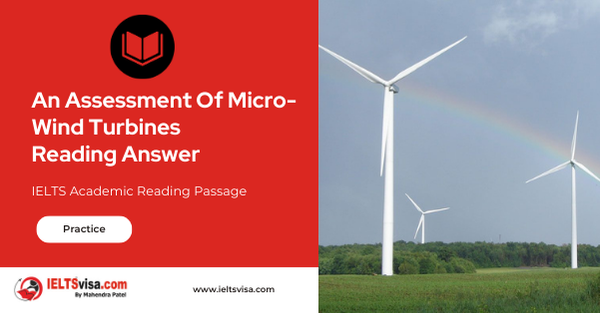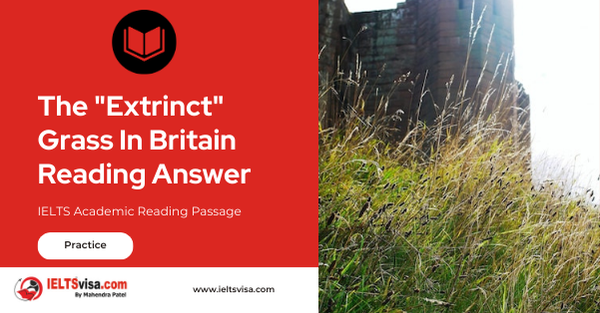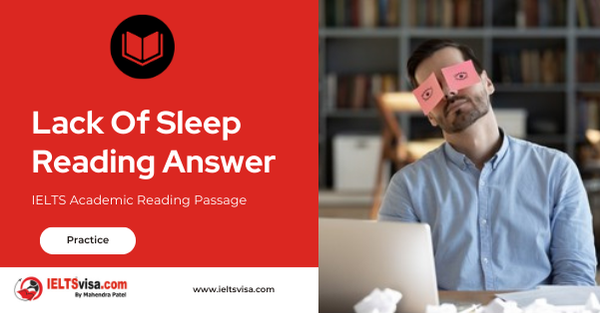An Assessment Of Micro-Wind Turbines Reading Answer
IELTS Academic Reading Passage
A
In terms of micro-renewable energy sources suitable for private use, a 15-kilowatt (kW) turbine is at the biggest end of the spectrum. With a nine metre diameter and a pole as high as a four-storey house, this is the most efficient form of wind microturbine, and the sort of thing you could install only if you had plenty of space and money. According to one estimate, a 15-kW micro-turbine (that’s one with the maximum output), costing £41,000 to purchase and a further £9,000 to install, is capable of delivering 25,000 kilowatt-hours (kWh)’ of electricity each year if placed on a suitably windy site.
B
I don’t know of any credible studies of the greenhouse gas emissions involved in producing and installing turbines, so my estimates here are going to be even more broad than usual. However, it is worth trying. If turbine manufacture is about as carbon intensive per pound sterling of product as other generators and electrical motors, which seems a reasonable assumption, the carbon intensity of manufacture will be around 640 kilograms (kg) per £1,000 of value. Installation is probably about as carbon intensive as typical construction, at around 380 kg per £1,000. That makes the carbon footprint (the total amount of greenhouse gases that installing a turbine creates) 30 tonnes.
C
The carbon savings from wind-powered electricity generation depend on the carbon intensity of the electricity that you’re replacing. Let’s assume that your generation replaces the coal-fuelled part of the country’s energy mix. In other words, if you live in the UK, let’s say that rather than replacing typical grid electricity, which comes from a mix of coal, gas, oil and renewable energy sources, the effect of your turbine is to reduce the use of coal- fired power stations. That’s reasonable, because coal is the least preferable source in the electricity mix. In this case the carbon saving is roughly one kilogram per kWh, so you save 25 tonnes per year and pay back the embodied carbon in just 14 months – a great start.
D
The UK government has recently introduced a subsidy for renewable energy that pays individual producers 24p per energy unit on top of all the money they save on their own fuel bill, and on selling surplus electricity back to the grid at approximately 5p per unit. With all this taken into account, individuals would get back £7,250 per year on their investment. That pays back the costs in about six years. It makes good financial sense and, for people who care about the carbon savings for their own sake, it looks like a fantastic move. The carbon investment pays back in just over a year, and every year after that is a 25-tonne carbon saving. (It’s important to remember that all these sums rely on a wind turbine having a favourable location)
E
So, at face value, the turbine looks like a great idea environmentally, and a fairly good long-term investment economically for the person installing it. However, there is a crucial perspective missing from the analysis so far. Has the government spent its money wisely? It has invested 24p per unit into each micro-turbine. That works out at a massive £250 per tonne of carbon saved. My calculations tell me that had the government invested its money in offshore wind farms, instead of subsidising smaller domestic turbines, they would have broken even after eight years. In other words, the micro-turbine works out as a good investment for individuals, but only because the government spends, and arguably wastes, so much money subsidising it. Carbon savings are far lower too.
F
Nevertheless, although the micro-wind turbine subsidy doesn’t look like the very best way of spending government resources on climate change mitigation, we are talking about investing only about 0.075 percent per year of the nation’s GDP to get a one percent reduction in carbon emissions, which is a worthwhile benefit. In other words, it could be much better, but it could be worse. In addition, such investment helps to promote and sustain developing technology.
G
There is one extra favourable way of looking at the micro-wind turbine, even if it is not the single best way of investing money in cutting carbon. Input- output modelling has told us that it is actually quite difficult to spend money without having a negative carbon impact. So if the subsidy encourages people to spend their money on a carbon-reducing technology such as a wind turbine, rather than on carbon-producing goods like cars, and services such as overseas holidays, then the reductions in emissions will be greater than my simple sums above have suggested.
Questions 1-7
Reading Passage 2 has SEVEN paragraphs, A-G.
Choose the correct heading for each paragraph from the list of headings below.
Write the correct number, i-ix.
List of Headings
i. A better use for large sums of money.
ii. The environmental costs of manufacture and installation.
iii. Estimates of the number of micro-turbines in use.
iv. The environmental benefits of running a micro-turbine.
v. The size and output of the largest type of micro-turbine.
vi. A limited case for subsidising micro-turbines.
vii. Recent improvements in the design of micro-turbines.
viii. An indirect method of reducing carbon emissions.
ix. The financial benefits of running a micro-turbine.
1. Paragraph A
2. Paragraph B
3. Paragraph C
4. Paragraph D
5. Paragraph E
6. Paragraph F
7. Paragraph G
Questions 8-9
Choose TWO letters, A-E.
The list below contains some possible statements about micro wind-turbines.
Which TWO of these statements are made by the writer of the passage?
A In certain areas, permission is required to install them.
B Their exact energy output depends on their position.
C They probably take less energy to make than other engines.
D The UK government contributes towards their purchase cost.
E They can produce more energy than a household needs.
10. 10………………. would be a more effective target for government investment than micro-turbines.
11. An indirect benefit of subsidising micro-turbines is the support it provides for 11…………………
12. Most spending has a 12………………. effect on the environment.
13. If people buy a micro-turbine, they have less money to spend on things like foreign holidays and 13…………………

Solution:An Assessment Of Micro-Wind Turbines Reading Answer
| 1. v | 8. B OR E IN EITHER ORDER |
| 2. ii | 9. B OR E IN EITHER ORDER |
| 3. iv | 10. offshore wind farms |
| 4. ix | 11. developing technology |
| 5. i | 12. negative |
| 6. vi | 13. cars |
| 7. viii |
Review and Practice
- Regularly practice with IELTS reading samples and time yourself to get used to the pressure of the exam.
- Review your mistakes to understand where you went wrong and how to avoid similar errors in the future.
Our Books
Master IELTS Speaking Part 1
IELTS Writing Task 1 Book
IELTS Writing Task 2 Book
An Assessment Of Micro-Wind Turbines Reading Answer Explanation
| Question No | Question Type | Answer | Keywords | Supporting Sentence | Location of Keywords | Explanation |
|---|---|---|---|---|---|---|
| 1 | List of Headings | v | Maximum output, capable of delivering 25,000 kilowatt-hours (kWh)’ of electricity each year | According to one estimate, a 15-kW micro-turbine (that’s one with the maximum output), costing €41,000 to purchase and a further €9,000 to install, is capable of delivering 25,000 kilowatt-hours (kWh)’ of electricity each year if placed on a suitably windy site | Paragraph A, line 3 | The largest micro-turbine is a 15-kW turbine that can produce up to 25,000 kWh of electricity annually when placed on a windy location. |
| 2 | List of Headings | ii | Carbon-intensity of manufacture | If turbine manufacture is about as carbon intensive per pound sterling of product as other generators and electrical motors, which seems a reasonable assumption, the carbon intensity of manufacture will be around 640 kilograms (kg) per €1,000 of value. Installation is probably about as carbon intensive as typical construction, at around 380 kg per €1,000 | Paragraph B, line 3 | Similar to other technologies, manufacturing and installing micro-wind turbines generates a carbon footprint. Although the author fails to find any research evidence stating the exact figure for the emissions, they estimate a value for the same. |
| 3 | List of Headings | iv | The effect of your turbine is to reduce the use of coal-fired power stations | In other words, if you live in the UK, let’s say that rather than replacing typical grid electricity, which comes from a mix of coal, gas, oil and renewable energy sources, the effect of your turbine is to reduce the use of coal-fired power stations. That’s reasonable, because coal is the least preferable source in the electricity mix | Paragraph C, line 3 | Micro-turbines are an effective approach to reducing carbon generation. It can replace coal in making grid electricity. |
| 4 | List of Headings | ix | Payback on their investment | The UK government has recently introduced a subsidy for renewable energy that pays individual producers 24p per energy unit on top of all the money they save on their own fuel bill, and on selling surplus electricity back to the grid at approximately 5p per unit. With all this taken into account, individuals would get back £7,250 per year on their investment | Paragraph D, line 1 | Besides being environmentally friendly, micro-turbines are also cost-effective. Even though the initial costs are high, the savings on fuel and electricity paired with government subsidies amount to an annual financial gain of around £7,250. |
| 5 | List of Headings | i | Broken even after eight years | My calculations tell me that had the government invested its money in offshore wind farms, instead of subsidizing smaller domestic turbines, they would have broken even after eight years | Paragraph E, line 5 | While on the surface, micro-turbines look like a terrific option, upon minute observation, the author believes that the government would have profited if they invested in offshore wind farms rather than domestic turbines. |
| 6 | List of Headings | vi | Worthwhile benefit, promote, and sustain developing technology | Nevertheless, although the micro-wind turbine subsidy doesn’t look like the very best way of spending government resources on climate change mitigation, we are talking about investing only about 0.075 percent per year of the nation’s GDP to get a one percent reduction in carbon emissions, which is a worthwhile benefit. In other words, it could be much better, but it could be worse. In addition, such investment helps to promote and sustain developing technology. | Paragraph F, lines 1-3 | Whilst the author believes that subsidizing micro-turbines is an ineffective use of government resources, it has positive implications in mitigating carbon emissions and promoting new-age technologies. |
| 7 | List of Headings | viii | Spend their money on a carbon-reducing technology, reductions in emissions | So if the subsidy encourages people to spend their money on a carbon-reducing technology such as a wind turbine, rather than on carbon-producing goods like cars, and services such as overseas holidays, then the reductions in emissions will be greater than my simple sums above have suggested. | Paragraph G, line 3 | Subsidizing micro-turbines can have some hidden benefits. Government subsidies on carbon-reducing aids can inspire people to invest in these, which can, in turn, cut their expenditure on carbon-emitting products and activities. |
| 8 | Choose TWO letter | B | Capable of delivering, suitably windy site | According to one estimate, a 15-kW micro-turbine (that’s one with the maximum output), costing €41,000 to purchase and a further €9,000 to install, is capable of delivering 25,000 kilowatt-hours (kWh)’ of electricity each year if placed on a suitably windy site. | Paragraph A, line 3 | Although in the case of a micro-turbine, the initial purchasing and installation costs are high, these can yield up to 25,000 kWh annually when seated in a correct location with the adequate wind flow. |
| 9 | Choose TWO letter | E | Micro-renewable energy sources, private use, biggest end of the spectrum | In terms of micro-renewable energy sources suitable for private use, a 15-kilowatt (kW) turbine is at the biggest end of the spectrum. | Paragraph A, line 1 | Micro-wind turbines are a smart choice for those concerned about carbon emissions. As a micro-renewable energy source, the 15 kW turbine is capable of yielding sufficient energy for private consumption. |
| 10 | Complete the sentences | Offshore wind farms | Invested its money in offshore wind farms, broken even after eight years | My calculations tell me that had the government invested its money in offshore wind farms, instead of subsidizing smaller domestic turbines, they would have broken even after eight years. | Paragraph E, line 5 | The passage states that the government has spent a considerable amount of wealth on domestic turbines and has subsidized such technology. However, they would attain break-even in eight years had they invested in offshore wind farms and benefitted more. |
| 11 | Complete the sentences | developing technology | Promote and sustain developing technology. | In addition, such investment helps to promote and sustain developing technology. | Paragraph F, line 3 | The author opines that subsidizing micro wind turbines is not the ideal way to spend government resources. However, there is a silver lining. A collateral benefit of such subsidies is that it aids other developing technologies. |
| 12 | Complete the sentences | negative | Negative carbon impact | Input-output modeling has told us that it is actually quite difficult to spend money without having a negative carbon impact. | Paragraph G, line 2 | Throughout the passage, the author points out different aspects of micro-wind turbines and their subsidized prices. In the end, it is seen that money spent towards the carbon-cutting efforts still hurts the environment. |
| 13 | Complete the sentences | cars | Subsidy encourages people to spend their money on a carbon-reducing technology, carbon-producing goods, reductions in emissions | So, if the subsidy encourages people to spend their money on a carbon-reducing technology such as a wind turbine, rather than on carbon-producing goods like cars, and services such as overseas holidays, then the reductions in emissions will be greater than my simple sums above have suggested. | Paragraph G, line 3 | The author is not in favor of subsidizing carbon-reducing mechanisms. Nevertheless, he believes that if such endowments motivate people to invest in environmental technologies, then they would have less money to spend on carbon-emitting goods and services. |
Practice IELTS Other Modules
IELTS Listening
The IELTS Listening test assesses how well you can understand spoken English in various contexts. It lasts about 30 minutes and is divided into four sections with a total of 40 questions. The listening tasks become increasingly difficult as the test progresses.
IELTS Academic Reading
The IELTS Academic Reading section assesses your ability to understand and interpret a variety of texts in academic settings. It is designed to evaluate a range of reading skills, including skimming for gist, reading for main ideas, reading for detail, understanding inferences, and recognizing a writer's opinions and arguments.
IELTS Speaking
The IELTS Speaking test assesses your ability to communicate in English on everyday topics. It lasts 11-14 minutes and consists of three parts: introduction, cue card, and a discussion based on the cue card topic.
IELTS General Reading
IELTS General Reading tests your ability to understand and interpret various types of texts. Here are some key areas and types of content you can expect to encounter in the reading section, along with tips for effective preparation.
IELTS Academic Writing Task 1
In IELTS Academic Writing Task 1, you are presented with a visual representation of information, such as graphs, charts, tables, or diagrams, and you are required to summarize, compare, or explain the data in your own words.
IELTS General Writing Task 1
In IELTS General Writing Task 1, you are required to write a letter based on a given situation. The letter can be formal, semi-formal, or informal, depending on the prompt. Here’s a breakdown of the key components to include in your letter
IELTS Academic Writing Task 2
In IELTS Academic Writing Task 2, you are required to write an essay in response to a question or topic. Here’s a guide to help you understand the essential elements of this task
IELTS Exam Tips
To succeed in the IELTS exam, practice regularly, familiarize yourself with the test format, improve your vocabulary, develop time management skills, and take mock tests to build confidence.
Grammer for IELTS
Grammar is the foundation of effective communication in English. Understanding tense usage, subject-verb agreement, and sentence structure enhances clarity and coherence in writing and speaking.
Vocabulary for IELTS
Vocabulary plays a crucial role in the IELTS (International English Language Testing System) exam, especially in the Speaking and Writing sections. Here’s an overview of why vocabulary is important and how it impacts your performance
RECENT IELTS SAMPLES QUESTIONS AND ANSWERS
Becoming An Expert Reading Answer
A Expertise is commitment coupled with creativity. Specifically, it is the commitment of...
STUDY CENTRE COURSES Reading Answer
SELF-STUDY TIPS AHowever difficult you find it to arrange your time, it will pay off in the...
The Extrinct Grass In Britain Reading Answer
A The British grass interrupted brome was said to be extinct, just like the Dodo. Called...
Morse Code Reading Answer
A. A new satellite-based system is being implemented to replace Morse code for sending...
Magnetic Therapy Reading Answer
AMagnetic therapy, which is a $5-billion market worldwide, is a form of alternative medicine...
Lack Of Sleep Reading Answer
Section A It is estimated that the average man or woman needs between seven-and-a-half and...













